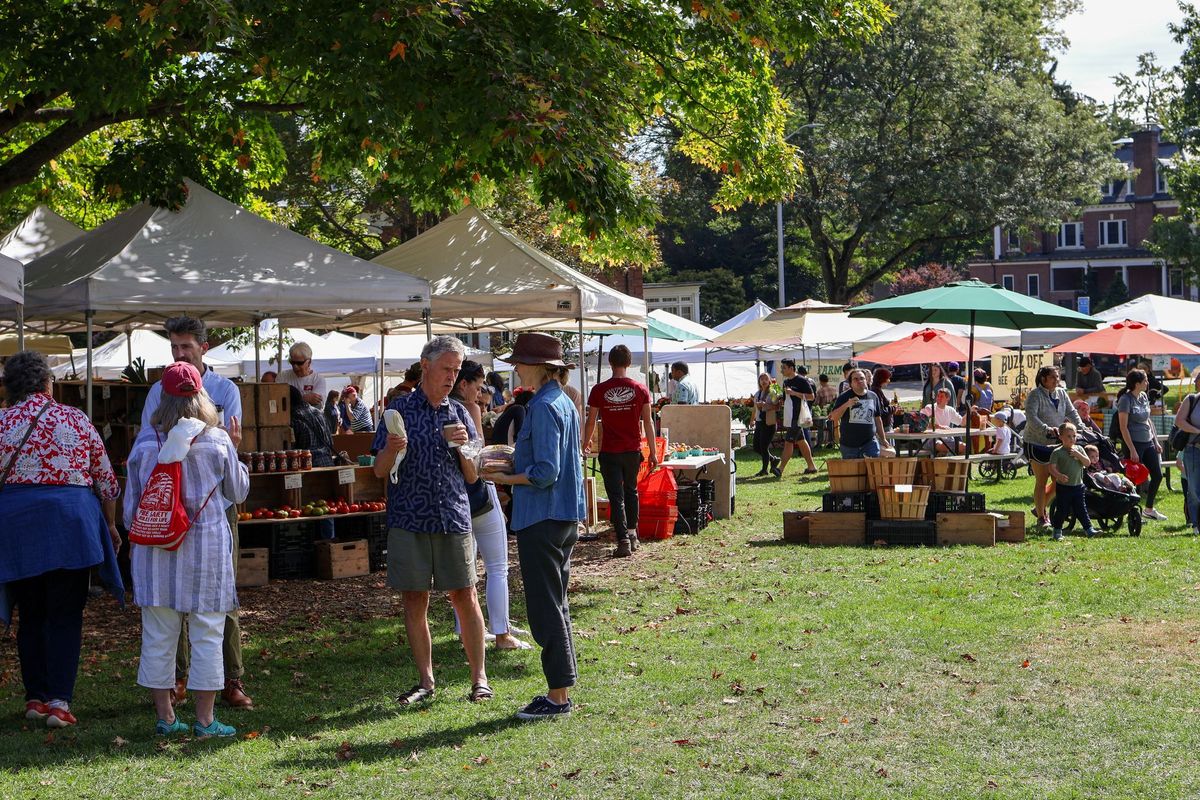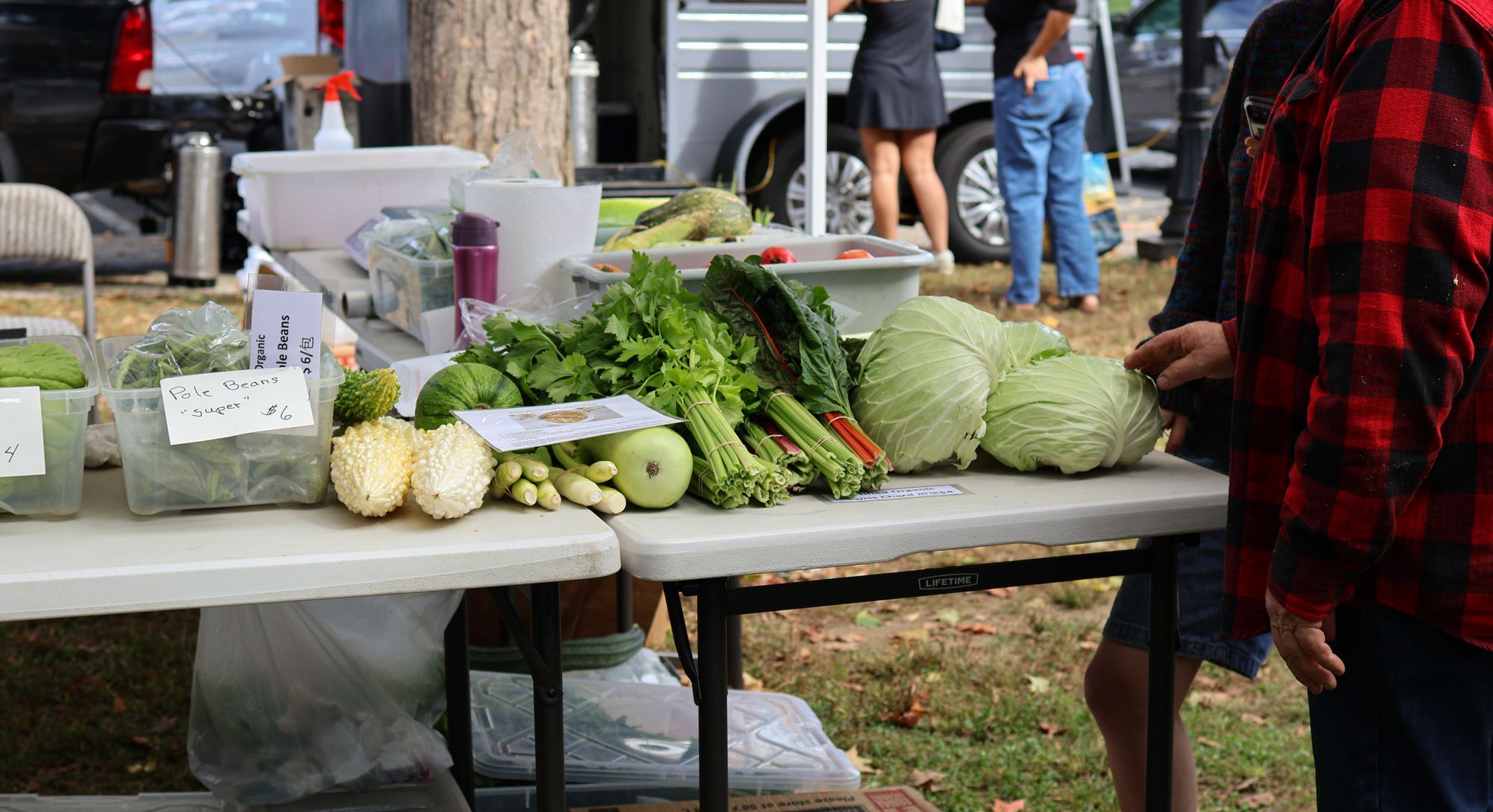Taking a Stroll Through The Amherst Farmers’ Market
Senior Managing Editor June Dorsch ’27 takes a trip to Amherst’s Farmers’ Market to learn more about its vendors, customers, and the community they have created.

On Saturday mornings, a noticeable energy fills the Amherst town green: children frolic in the grass while their parents chat by the picnic tables. College students stroll around, sipping drinks from the Stout Pigeon Coffee cart. Older couples hold hands as they examine the produce offered at a farm stand. A man plays guitar and sings “Blackbird” by The Beatles. Sometimes, fluffy bunnies can even be seen hopping by.
This is the Amherst Farmers’ Market, where dozens of local vendors and farmers sell their goods from 8 a.m. to 1:30 p.m. weekly on Saturdays, April through November. It was established in 1972 by a collection of people affiliated with Amherst College, Hampshire College, and the University of Massachusetts, Amherst who saw a need for a venue for local produce and product.
For over fifty years, it has been a community staple and has connected surrounding colleges with the town.
Becoming a Part of the Farmers’ Market
A lot happens behind the scenes to make the farmers’ market run smoothly. Market manager David Machowski handles town relations and logistics, ensuring that all vendors have to take care of on Saturdays are setting up, selling their products, and packing up. There is also a committee made up of six market vendors and one member of the town’s Agricultural Commission, which selects which vendors get to be a part of the farmers’ market.
Potential interested vendors reach out to Machowski to have their business be a part of the farmers’ market. Then they go through an application process, which Joyce Douthright of Cold Spring Soapery described as “just a lot of paperwork and [a] check.”
“The application asks you a lot of questions,” founder of Egg & Company Carter Adams said. “Like, ‘Where do you get your supplies from?’ They want it to be as central to Amherst as possible.”

The committee also focuses on making sure there is a diversity of vendors.
“There’s already a vendor that sells this specific product, and so [the committee doesn’t] want to add too much competition to mess with their sales, and obviously seniority wins,” Adams said.
Musicians do not apply to be part of the farmers’ market like vendors do. Instead, they have trial periods before they get to become regular performers at the market.
“[Machowski] said, ‘Well, come on up to North Amherst,’ where they sometimes run the farmers’ market. And that was kind of an audition. That was a rainy day with about three stalls and that many people coming around. But I sang my heart out, and he said, ‘Well, come down to the one here in the middle of town,’” Musician and retired music teacher Paul Kaplan explained. He now plays at the farmers’ market two or three times a summer.
A Day at the Farmers’ Market
The day begins with the Machowski and volunteers setting up around 5:30 a.m. They tow cars if necessary and work with vendors to see if there is anything they need when they arrive.
Vendors come in around 6:30 or 7 a.m. to set up their booths.
“Most of the stuff that we bring, of course, was harvested the day before and stored overnight in our coolers, and it takes a certain amount of time to load that up and shelve them,” said Ernie Kelley of Kelley Farms. “We live about a 35, 40-minute drive away, so we’re usually pretty busy in the morning before we get here.”
Douthright estimated it takes roughly an hour to set up, but for certain vendors, it takes longer. Most businesses will bring a car or truck with their materials, park it, and just unpack close to their booth. However, since the town has stopped letting vendors park their vehicles on the grass, vendors who have booths far from a sidewalk have to cart everything across the green.

According to Jerome Haines, who works at the Bread Euphoria booth with his wife Erin Mahon-Moore Haines, “it’s always a little quiet” when vendors start selling at 8 a.m. At 10 a.m., people start to fill the market, and for the rest of the day, it remains packed. Machowski estimated that on average, 4,000 to 4,400 people visit the market, but it can get as high as 5,000. Almost every interview I conducted had to be paused at some point because customers came up to purchase goods, and all vendors interviewed said they earn great profits at the market.
Community
Everyone from musicians to customers to vendors to volunteers said that what they loved about the farmers’ market was the community.
“It’s very joyful — a lot of joy in the air,” Aidan Cooper ’26 said.
“People are so friendly. We have repeat customers who come and visit and ask about us,” said Mahon-Moore Haines.

Mahon-Moore Haines and Haines got married last week, so they were not at the farmers’ market last Saturday. They remarked that several customers asked where they were when they returned this week.
Vendors also have close relationships with each other. If someone needs to step away for a bit, another vendor will help run their booth while they’re gone. Certain vendors even trade goods with each other.
“Red Fire Farm and Egg & Company trade every week. They never pay for breakfast … We all never pay for produce,” Adams said. “You can trade with whoever you want. So [for example] whenever I mess up an order, I give it to [Dave Drugan from Buzz Off Bee Company]. So it’s just a surprise to him every single time. And then he just gives me honey whenever.”
Junie Haus, a volunteer, said she has noticed that the farmers’ market has bridged the town-college divide in recent years.
“Farmers’ markets have sometimes been seen as a space for older individuals … people who have good income or whatever … We’ve had a hard time bringing younger audiences into the market, [but] one of the silver linings of Covid is that we started to see more students because there was not much you could do besides go outside. This is one of the few places that was open,” she said.
What’s Next for the Farmers’ Market
Haus wants to make the market “a little more hands-on, a little more [engaging],” by organizing more special activities like the paper-making pop-up she ran one week or a candle-making station.

She also is focused on “continuing to make this a diverse space and a welcoming space for everybody.”
Customers had no complaints about the market; the only change they wanted was to see more people, especially college students, attend.
Cooper said, “If more people are interested, [if] more people know about it, they’re going to come, and then more people want to set up booths, which means it just gets bigger and bigger.”






Comments ()